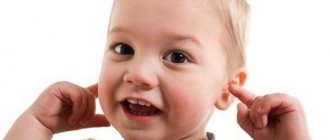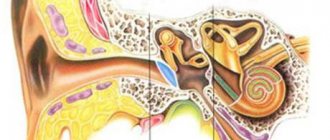Sensorineural hearing loss, also known as acoustic neuritis, is one of the most common diseases of the hearing system. This disease (or deviation) is damage to the structures of the inner ear, which entails partial or absolute hearing loss. Hearing loss is caused by disturbances in the hair cells of the spiral organ in the cochlea of the inner ear. The main symptoms of sensorineural hearing loss are hearing loss; you can often hear some kind of hum or constant noise in the ear, the frequency of which can be either low or high.
Sensorineural hearing loss: what is it?
Sensorineural hearing loss is a hearing impairment caused by damage to the auditory analyzer and manifested by unilateral or bilateral hearing loss, tinnitus, as well as resulting disturbances in social adaptation.
Hearing is one of the sense organs that ensures a normal quality of human life. When it is damaged, a person cannot fully perceive the sounds of the surrounding world: speech, music, industrial noise, and so on. In 73% of cases, hearing impairment is caused by sensorineural hearing loss. In this condition, one portion of the auditory nerve is damaged, often permanently.
To this day, there remains “confusion” with the designation of the diagnosis. On the Internet, medical reports and old monographs you can find the following terms: cochlear neuritis, neuritis/neuropathy of the auditory nerve, perceptual hearing loss. All these are outdated concepts that lost their relevance in 1992 with the release of the 10th edition of the International Classification of Pathologies (ICD-10). These recommendations proposed a general concept - “sensorineural hearing loss”.
Prevention, complications, consequences
The functioning of the hearing organs is influenced by many factors. That is why it is so important to provide comprehensive prevention of sensorineural hearing loss. It should include the following components:
- eliminating the negative impact of noise and vibration;
- cessation of drinking alcohol and smoking;
- use of ototoxic drugs exclusively for health reasons and only in combination with detoxification therapy;
- the use of detoxification agents and drugs to improve microcirculation in the presence of infectious diseases.
With timely treatment of sensorineural hearing loss, the prognosis is favorable in approximately half of the cases. If a person develops a chronic form of the disease, it is necessary to achieve stabilization of hearing. Subsequently, rehabilitation is carried out by performing cochlear implantation or prosthetics.
Watch a popular video about the causes of hearing loss:
Sensorineural hearing loss is considered a fairly serious disorder that can lead to complete hearing loss. To prevent this from happening, it is very important to consult a doctor as soon as possible, who, after a thorough diagnosis, will select complex therapy.
Causes of neurosensory disorders
Among the main factors in the development of this disease, the leading place belongs to infectious processes. The risk of hearing loss increases significantly in people exposed to viral illnesses (flu, mumps). In this matter, great importance is given to the state of immunity. Weakened body defenses affect the severity of the disease and lead to the development of various types of complications, including the auditory system.
It is reported that between 13% and approximately 30% of patients previously diagnosed with meningitis suffer from hearing loss. Also, the well-known syphilis can lead to hearing loss.
Sensorineural hearing loss often develops against the background of improper nutrition of the central nervous system and hearing organs. Such conditions include pathologies of the cardiovascular system, atherosclerosis, and thrombosis. Frequent stress is also a predisposing factor. To eliminate the likelihood of developing this disease, it is important to limit the negative impact of irritants, change your area of activity or even your lifestyle.
The cause of hearing loss can be a serious traumatic brain injury, or so-called acoustic trauma, when a sharp increase in pressure in the inner ear is recorded due to an excessively loud sound.
In some cases, sensorineural hearing loss develops due to constant exposure to toxic substances (chemicals, certain categories of medications). In some cases, hearing disappears for no apparent reason. Experts in this matter primarily suspect vascular disorders, but it is almost impossible to confirm this assumption instrumentally. In this case, the idiopathic variant of the disease is considered.
Risk factors for hearing loss include:
- Elderly age.
- Oncological pathologies.
- Otosclerosis.
- Congenital/acquired anomalies in the structure of the hearing aid.
Experts warn that obesity and diabetes also affect the incidence of this disease.
Causes
Doctors identify several reasons that can lead to the development of sensorineural hearing loss:
- Infectious diseases (influenza, parainfluenza, adenovirus infection, syphilis, measles, mumps, scarlet fever).
- Bacterial damage to the structures of the auditory analyzer in otitis media, labyrinthitis, meningitis.
- Hereditary diseases.
- Developmental defects.
- Vascular disorders: osteochondrosis of the cervical spine, arterial hypertension, atherosclerosis of cerebral vessels. All these diseases lead to circulatory disorders in the cerebral vessels that supply the structures of the auditory analyzer.
- Toxic effects of certain drugs. These can be aminoglycoside antibiotics (Gentamicin, Kanamycin), streptomycins, diuretics (Furosemide, Ethacrynic acid), salicylic acid derivatives (Aspirin).
- Injuries: traumatic brain injuries, barotrauma (during sudden changes in atmospheric pressure, which is observed when immersed in water), acoustic injuries (when exposed to intense sound).
- Occupational factors, such as excessive noise levels in the workplace.
- Allergic, autoimmune diseases.
- Age-related changes manifested by atrophy of the neuroreceptor apparatus.
- Tumor formations: acoustic neuroma, neoplasms of the middle ear, brain.
Classification
Types of sensorineural hearing loss can be considered according to several criteria. If we focus on its origin, then it will be congenital or acquired: the latter is much more common. The main criteria for classifying this type of hearing loss are:
- location of the pathology;
- rate of disease development;
- degree of deafness.
Due to the fact that neurosensory hearing defect is caused by damage only to the nerve trunk, and the brain is not affected, the pathology is predominantly one-sided (right- or left-sided). Bilateral sensorineural hearing loss is diagnosed less frequently and is divided into:
- symmetrical - when the same hearing problems are observed on both sides;
- asymmetrical – with a difference in sound perception impairment (the 1st ear hears better than the 2nd).
Not the least important criterion is the rate of development of the disease, which takes into account the speed with which the pathology makes itself felt and the duration of the persistence of the main symptoms. In official medicine, the following forms of hearing loss are distinguished according to the sensorineural type:
- Sudden – symptoms develop quickly (mainly within 12 hours) and persist for several weeks (up to 3).
- Acute – signs of the disease begin to manifest themselves and increase in intensity within 3 days and persist for a month.
- Subacute - the development of symptoms occurs within 1-3 weeks, the problem worries from a month to 3.
- Chronic - the rate of development is the same as in the subacute form, but the disease manifests itself for several months (longer than 3) and can provoke disorders that cannot be restored (including atrophy of the auditory nerve).
External manifestations of the pathological condition
Symptoms of sensorineural hearing loss depend on certain signs of the course and occurrence of the disease. Signs of hearing loss vary depending on the course of the disease.
Acute sensorineural hearing loss can last for 30 days. During this period, pathological changes occur in the spiral organ. At this stage, hearing restoration is possible if the disease is diagnosed within 3 months from the onset of symptoms.
And only after several months does hearing loss begin to manifest itself in the form of tinnitus, congestion in the ear canal, and deterioration in the child’s well-being. If a child has suffered from infectious diseases in acute or chronic form, then he is already at risk.
Symptoms of sensorineural hearing loss depend on the location of the organ damage. Hearing loss is also classified according to the severity of the disease and the age of the patient. The degree of hearing loss is determined by a special program - an audiogram. Symptoms of hearing loss vary depending on the dysfunction and sensitivity of the eardrum to sounds and noise of varying degrees (in decibels).
According to the severity of the disease, symptoms such as nausea, gag reflex, severe headache, tinnitus, and disruption of the vestibular apparatus are distinguished. Also, symptoms may appear depending on the patient’s age and the influence of external factors on the development and functioning of the body.
Symptoms of sensorineural hearing loss in adults
When hearing loss occurs, unilateral or bilateral hearing loss may occur. In this case, you may experience symptoms:
- audibility of noises, ringing;
- dizziness;
- nausea attacks;
- gagging;
- vestibular disorders.
The patient may develop a psychoemotional disorder if a long process of chronic hearing loss occurs with a lack of audibility. The patient has:
- decreased vitality;
- irritation;
- restless state;
- anxiety;
- lack of contact with other people;
- loss of working ability.
Elderly people are often accompanied by cerebrovascular diseases. When audibility is lost completely or by half and appropriate actions for auditory correction are not carried out, sclerosis, thinking problems, delusions, and hallucinations may progress.
If the disease develops rapidly, then the manifestation of clinical symptoms is sudden, despite external well-being. In some cases, a decrease in hearing function occurs within a week.
In subacute and chronic hearing loss, development may take a longer period, lasting up to five months. It is imperative to visit a specialist to have your hearing tested, this will help avoid deterioration in its quality.
Deafness and hearing loss in a child
Children of all ages can suffer from all types and forms of hearing loss or deafness. The most common cases of congenital and genetic hearing loss in children occur; acquired deafness develops less frequently. Among cases of acquired deafness, most are caused by taking medications that are toxic to the ear and complications of infectious diseases.
The course, mechanisms of development and treatment of deafness and hearing loss in children are the same as in adults. However, the treatment of hearing loss in children is given greater importance than in adults, since for this age category hearing is critical for mastering and maintaining speech skills, without which the child will become not only deaf, but also dumb. Otherwise, there are no fundamental differences in the course, causes and treatment of hearing loss in children and adults.











